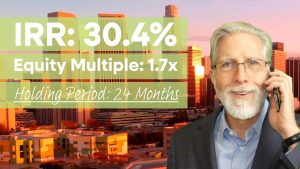Takeaways
- Tsunami of loans on office properties are coming due.
- Banks are not enthusiastic about refinancing office loans.
- Creating opportunities for adaptive reuse or redevelopment.
According to the Mortgage Bankers Association, banks currently – in the second quarter of 2023 – have about $1.75 trillion in debt on their books that’s collateralized by income-producing commercial real estate. Note the distinction. We’re talking about investment properties, not owner-occupied properties. Over the next couple of years, about 42% of that debt will be maturing. That’s about $714 billion in debt coming due. Breaking it down a little bit more, about $156 billion of that debt coming due is collateralized by office properties. What really gets my attention is how that figure, $156 billion, is almost half of all the office loans outstanding at banks. It’s 46%. Think about that for a moment. Some 46% of all the loans held by banks on income-producing office properties are coming due soon, in a period of time when office vacancies are at historic highs.
Good-As-New Office Building To Be Demolished
With that in mind, I just read in Commercial Observer this week that Kearny Real Estate Company has decided to demolish one of its office properties in Santa Ana, CA and redevelop the site with an industrial property. Kearny is an established and well-respected company that develops and invests in commercial properties in Southern California. They currently have some $1.9 billion in assets under management.
The details of this story are really compelling. Kearny acquired this office property in 2018 for $35MM. It was a two-building office park. One of them was a 3-story building and the other was a 5-story building. It total, the buildings had 197,000 SF of net rentable area. Having been built in 1982, they were starting to get a little dated, so Kearney invested substantially, perhaps as much as $15MM, in a yearlong renovation. It was very much meant to be a value-add play, one that would reposition the asset, taking advantage of the campus feel of its 8-acre site, building up the common area amenities and making it a much more competitive product in the market, one that could command premium rental rates.
Unfortunately, almost immediately after completing the renovation project in early 2020, just as Kearny was setting out to lease the property back up to stabilized occupancy at significantly higher rents, they, just like the rest of us, got waylaid by the COVID-19 pandemic. Here we are, some three years after that, in a very much weakened, post-pandemic office market with ongoing work from home trends still very much suggesting how this is the new normal. It’s a secular change for the property type and we’re not going back to the pre-pandemic office environment.
Industrial Makes More Sense
In the Orange County market, where Santa Ana is located, vacancy for Class A office product has increased to 16.3%, according to the most recent data from CBRE. At the same time, the scarcity of developable land in Orange County, along with growing demand for industrial properties, in particular warehouse/distribution and last-mile logistics inventory with modern technologies and amenities, has squashed the vacancy for industrial down to less than 1%. Specifically, it’s 0.7% as per CBRE. That’s a record-low vacancy in the region. Not surprisingly, rental rates for industrial are also breaking records, currently up by 18% on a year over year basis.
So, given these circumstances, what’s an agile and experienced investor like Kearny to do? They’ve decided to completely raze the existing improvements, which are arguably as good as new, and replace them with a 163,000 SF, state-of-the-art, industrial facility. Construction on that industrial property is expected to begin in the first quarter of 2024.
Not Enthusiastic About Refinancing Office Loans
Obviously, this is just one property. It doesn’t necessarily represent the entire market. That said, I find this story very instructive, maybe even a sign of things to come. Think about all those office loans coming due this year and next. As I said, it’s about $156 billion. Given the disruptive changes in the office market that were brought on by the COVID-19 pandemic; the swift and significant increase in interest rates over the past 14 or so months; and ongoing concerns about inflation on the one hand and recession on the other, banks are not likely to be enthusiastic about refinancing a lot of these office loans. If they do, we have to assume that borrowers will need to modify their capital stacks. In other words, they’ll be forced to bring more equity to the deal.
Underwriters at these banks are going to be conservative and market values for a lot of these office properties have likely come down significantly since they were last financed. The only reason that isn’t already a given is a lack of transactions. According to CoStar, transaction volume for office sales in the United States is currently down by about 72% on a year-over-year basis. As a result, we don’t have the benefit of price discovery, which only exacerbates the lack of clarity.
Giving Back the Keys
What if the borrowers don’t have the needed equity to refinance their office properties? Maybe even worse, what if they decide it’s a lost cause, it’s just not worth the effort, because their property is an older, less competitive office building? Are they simply going to hand over the keys to the bank? We’ve already seen some recent and very dramatic examples of this.
Blackstone, one of the largest institutional investors of commercial real estate in the world, did just that earlier this year, handing back the keys of an office tower in New York to Deutsche Bank. They did this, presumably, because the anchor tenant in the building didn’t renew their lease when it expired earlier this year. Paraphrasing what sources familiar with the situation indicated to Commercial Observer, investing the additional capital required to re-lease the property didn’t make any sense, given the continued uncertain recovery of the submarket. Blackstone is giving up this particular investment as a one-off strategy out of a fiduciary responsibility to its investors.
As a former banker, I can confirm that the last thing a bank ever wants to do is take back the keys. Banks are not developers, they’re not operators. They’re not going to take on the type of redevelopment project currently underway by Kearny and they’re certainly not going to take on the mammoth releasing plan needed for Blackstone’s former property in New York. If it didn’t make sense for Blackstone, why would it make sense for a bank.
Unprecedented Times Revel Opportunities
The beauty of being a banker is that you never underwrite to 100% loan-to-value. It’s usually much less than that. So, if you have to foreclose on a property and sell it at a loss, you’re going to recoup some, if not all, of your investment. That’s likely what’s going to play out over the next couple of years as all those office loans come due. Borrowers will either have to pay them down by bringing in more equity or they’ll give back the keys, in which case, banks will write down the loans and sell off the assets. Some of those office properties, especially the older ones, will likely be sold at or below land values. That may open up opportunities for adaptive reuse or redevelopment of some very desirable locations.
If you’re like most of my readers, you’ve got the gumption to make your own decisions based on available data, trends, and sentiment in the market. Keep your wits about you these next couple of years as we navigate these truly unprecedented times. It’s definitely going to be an interesting chapter in the lives of a lot of investors and may even propel some of us to much greater success.




















